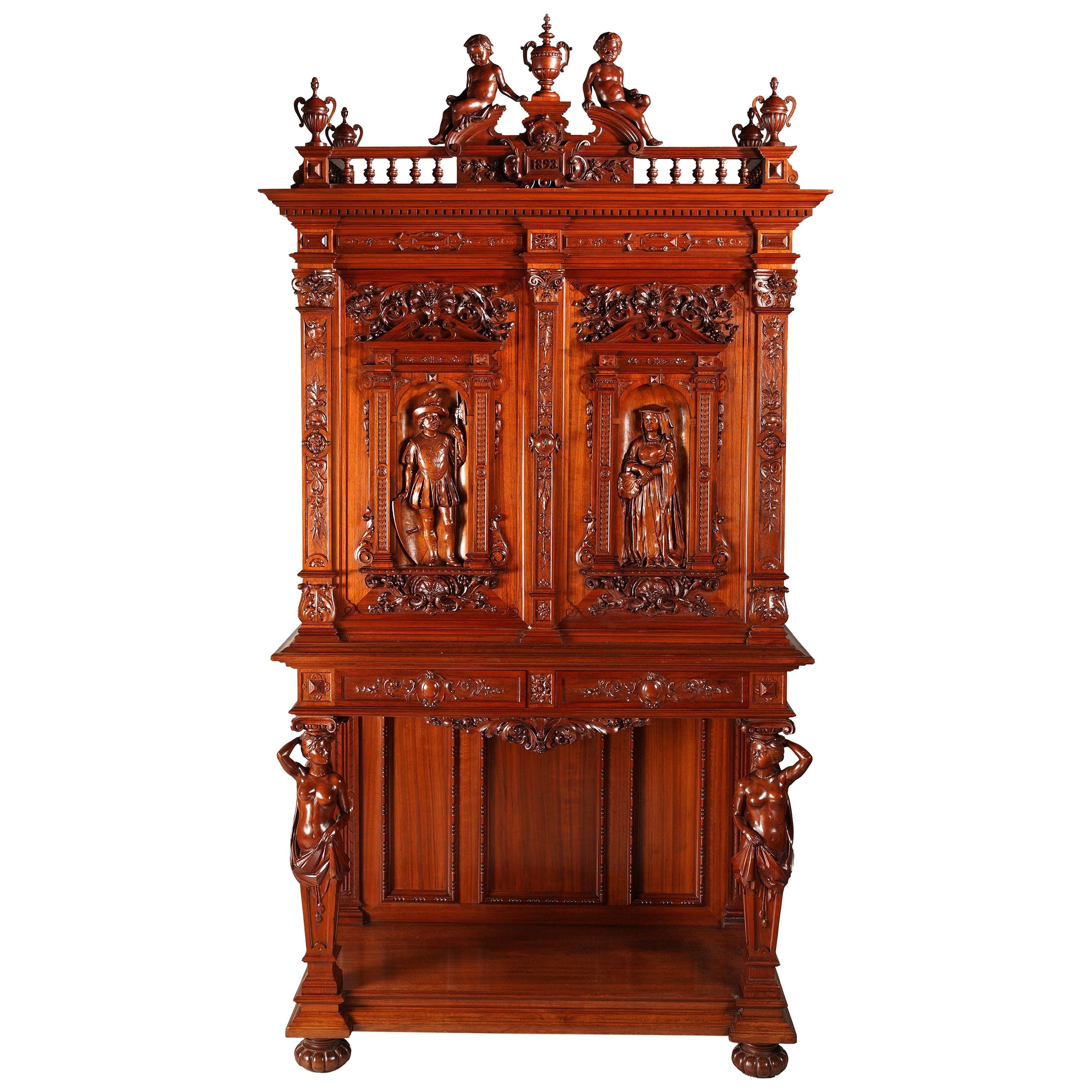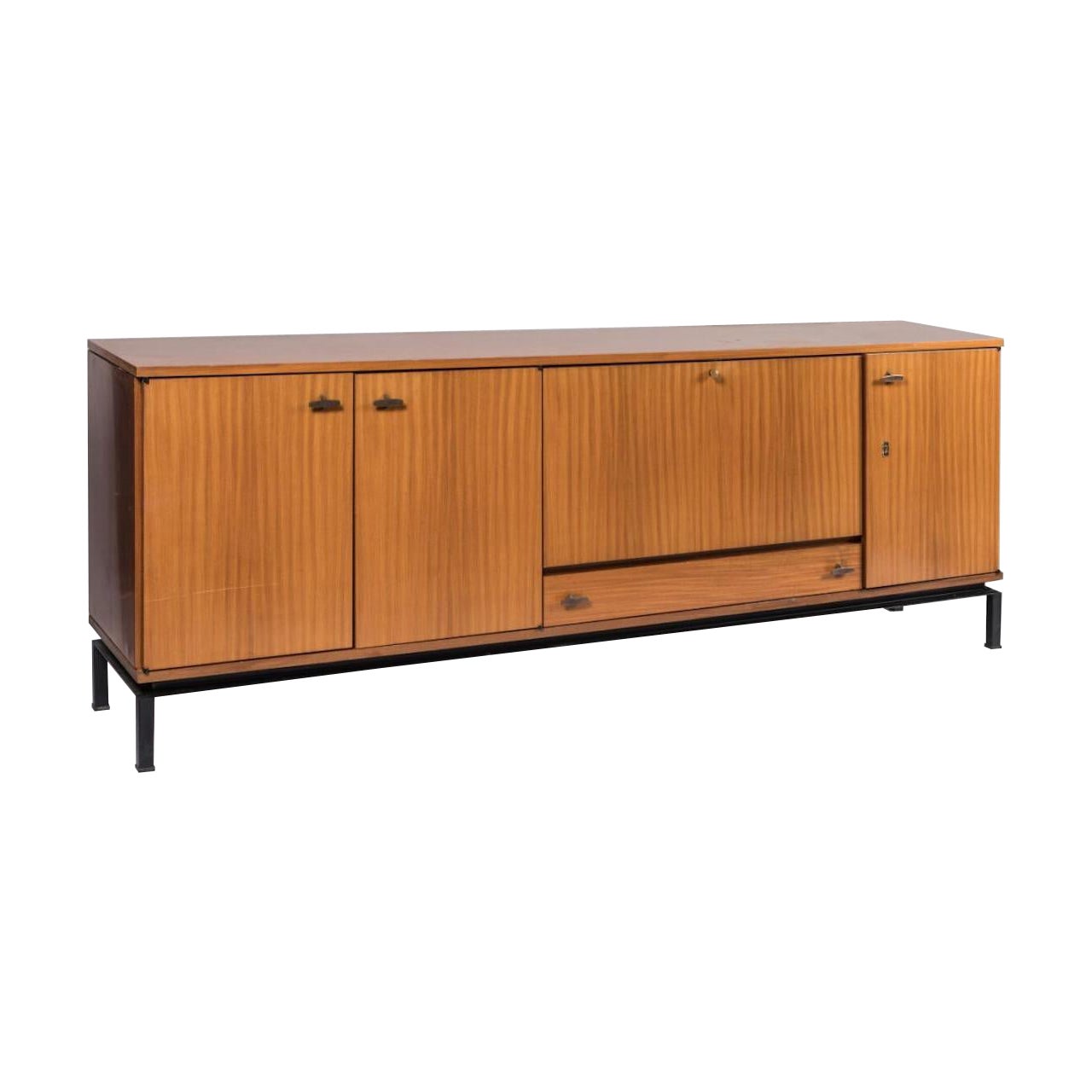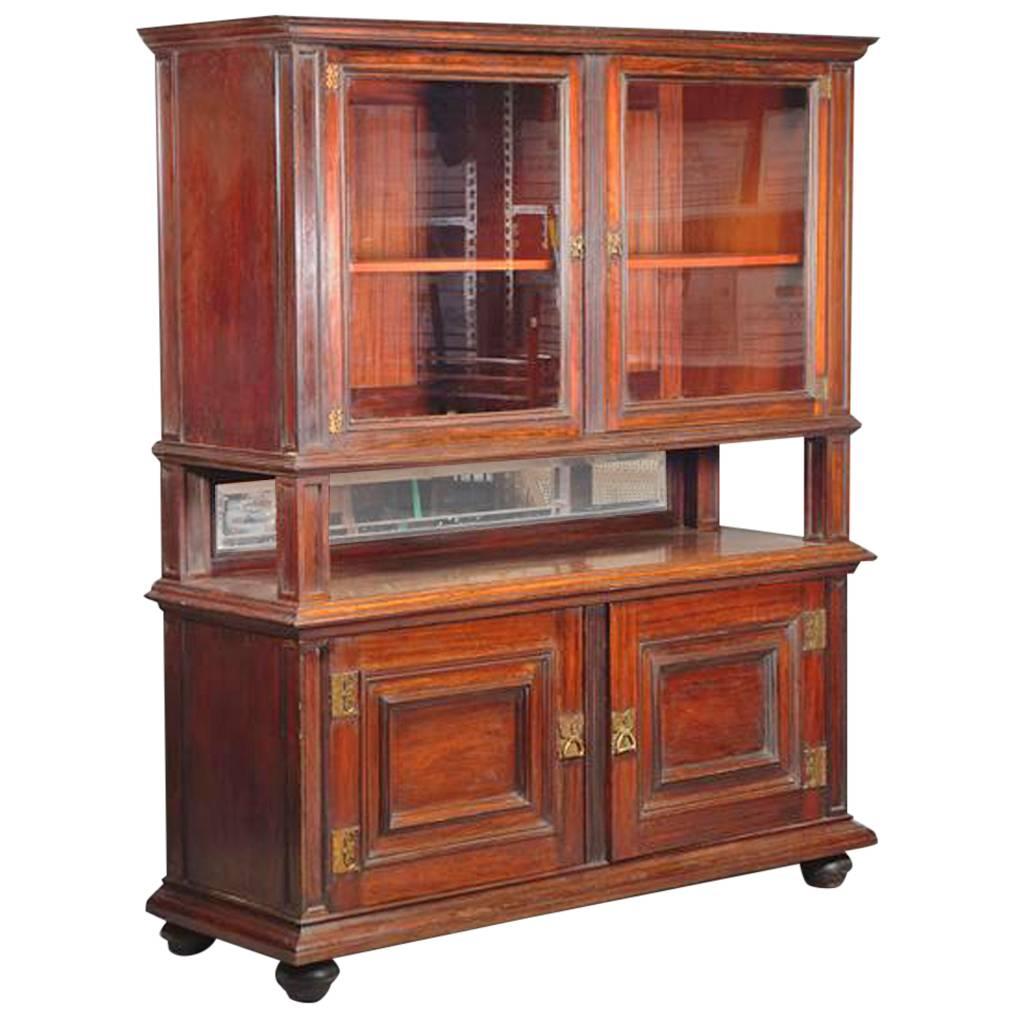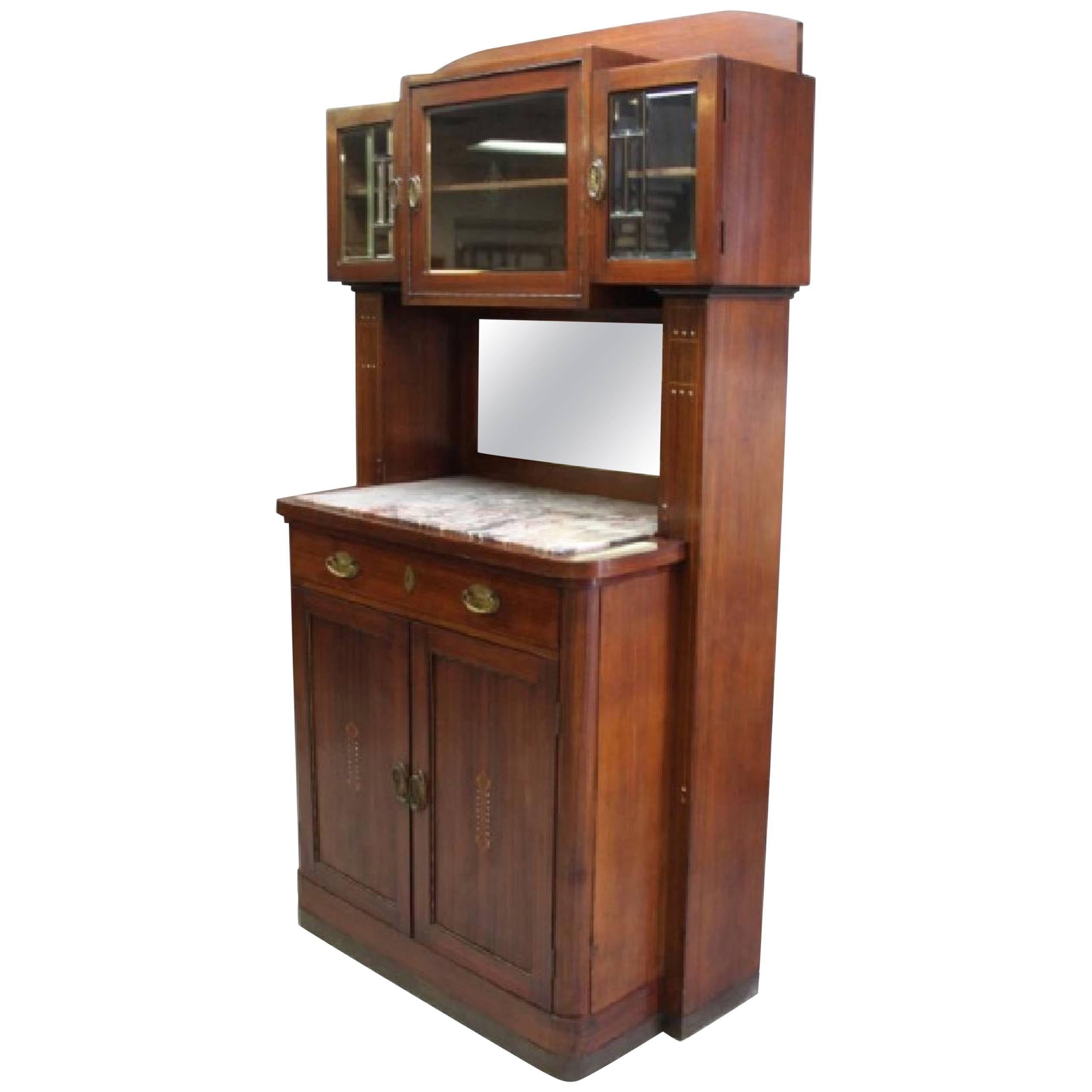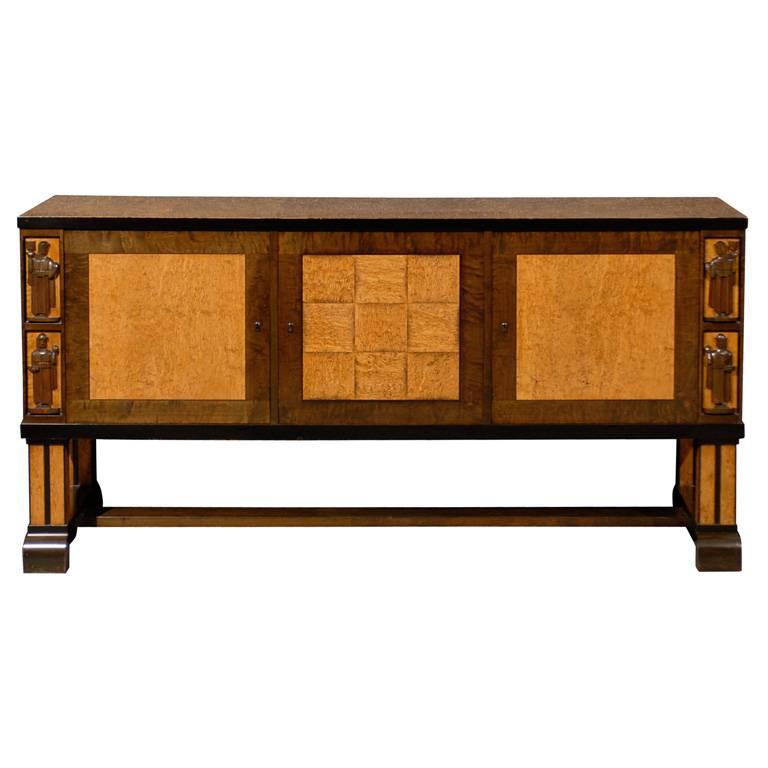Items Similar to Wooden & Enameled Display Sideboard Attributed to H.A Fourdinois, France, c1867
Want more images or videos?
Request additional images or videos from the seller
1 of 12
Wooden & Enameled Display Sideboard Attributed to H.A Fourdinois, France, c1867
About the Item
Important two-tiered sideboard attributed to H.A. Fourdinois made in natural and carved wood : the lower part made up of four panels, two concave ones and two doors, richly ornated with a polychrome enameled floral decoration and gilt bronze plaques.
A large dual drawer is surmounted by the upper part of the sideboard, opening with two glazed doors, framed by detached columns. The entire unit is topped with a pediment onto which a female bust is carved in relief within a medallion on a gilt background.
With a matching set of twelve chairs.
The Forney library in Paris preserves order registers of the Fourdinois as well as sketches books and pictures representing pieces of furniture made by the Fourdinois workshops. In this documentation, some elements enable us to link this sideboard with Henri-Auguste Fourdinois’ productions, such as the large scrolls linking the upper part to the lower part of the sideboard, as well as the detached columns carved at their lower third. (picture n°1 attached)
Notebook containing ink-sketches coming from the Fourdinois workshop shows a project for a pelmet, beautified with a centering trophy composed of a torch and a quiver within in a foliage wreath, this motif obviously reused by the Fourdinois on the central decoration of the panels of our sideboard. (picture n°2 attached)
The firm of Fourdinois, considered during the Second Empire as the greatest furniture manufacturer in Paris, was founded in 1835 by Alexandre-Georges Fourdinois (1799-1871). It was developped in the context of the Expositions Universelles. At the time, the firm already produces furniture of the Neo-Renaissance style, such as a dresser that won the Great Medal at the London Universal Exhibition of 1851. The son, Henri-Auguste Fourdinois (1830-1907), joined the firm in 1860 and will become head of the firm in 1867. The high quality of his designs was remarked at the Universal Exhibition in 1862, when the jury awarded him two medals « for Excellence of Composition and Execution ». Henri-Auguste, now sole in charge, brought the firm to the summit of its achievements at the 1867 Universal Exhibition in Paris by winning the Grand Prize for his stand. Apart from the commissions he executed for the « Mobilier de la Couronne », he also produced high quality furniture for the Parisian bourgeoisie. The firm is at its zenith during the years 1862-1880. At this time, it is considered as an example to follow for other cabinet-makers, whether they are French, British or American.
Through the quality of execution and the extreme care taken in the decoration of furniture, H.-A. Fourdinois was particularly appreciated by Napoleon III and Eugenie, who ordered him to furnish several imperial residences, such with the bedroom of the apartment of the Pope at Fontainebleau Palace. Among his talents, Fourdinois knew how to match furniture with elaborate and luxurious sets, thus causing him to become one of the preferred suppliers of the Empress Eugenie. His meticulous work was in particular made thanks to the new technique of “en plein” marquetry, a decorative technique invented by H.-A. Fourdinois himself, for which he registered a patent allowing him to have the monopoly to use this technique. This new technique is quite different from the traditional marquetry which put together wood sheets veneered on a furniture piece. In Fourdinois’ “en plein” marquetry, the inlaid wood is joined together with the wooden structure of the furniture piece, allowing the cabinet-maker to carve directly the inlaid wood. Such a technique enabled to inlay different types of wood inside the structure as well as precious stones, ivory, slate, etc.
- Attributed to:Henri-Auguste Fourdinois (Cabinetmaker)
- Dimensions:Height: 130.71 in (332 cm)Width: 78.75 in (200 cm)Depth: 21.26 in (54 cm)
- Sold As:Set of 13
- Style:Renaissance (In the Style Of)
- Materials and Techniques:
- Place of Origin:
- Period:
- Date of Manufacture:circa 1867
- Condition:Wear consistent with age and use.
- Seller Location:PARIS, FR
- Reference Number:
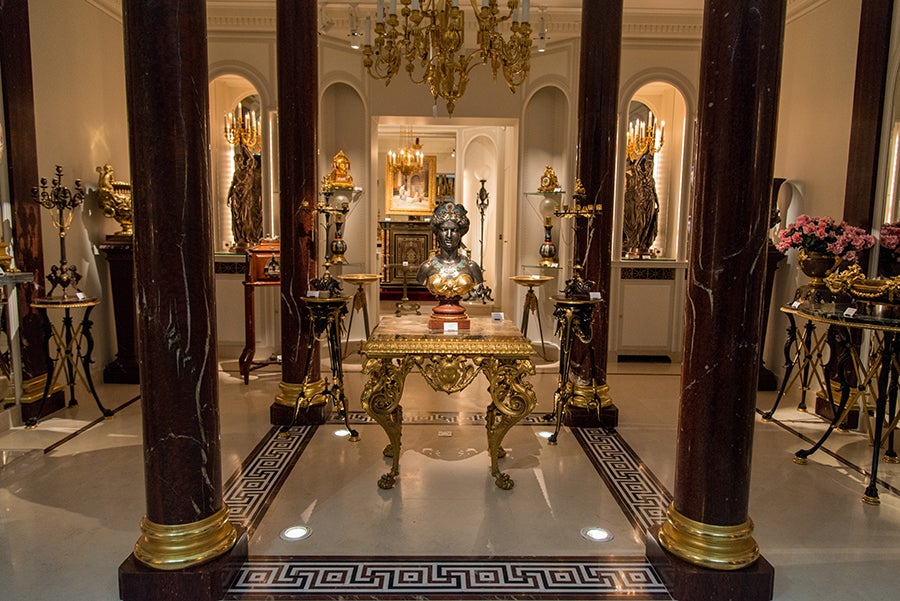
About the Seller
4.9
Vetted Seller
These experienced sellers undergo a comprehensive evaluation by our team of in-house experts.
Established in 1997
1stDibs seller since 2018
74 sales on 1stDibs
Typical response time: <1 hour
Associations
International Confederation of Art and Antique Dealers' Associations
- ShippingRetrieving quote...Ships From: Saint Ouen, France
- Return PolicyA return for this item may be initiated within 7 days of delivery.
More From This SellerView All
- Renaissance Style Wooden Cabinet Attributed to H.A. Fourdinois, France, 1893Located in PARIS, FRA wooden cupboard, elaborately carved throughout, dated "1893" on the crest and attributed to H.A. Fourdinois. The upper section with a pair of cherubs at the center of a balustrade ornamented with two-handled urns, two architectonic doors below, carved with lady and gentleman in niches surrounded by extensive carving with classical motifs. The lower section with two drawers above a standing female caryatid support at each front corner. The all reposing on four gadronned round feet. The Fourdinois company was founded in 1835 by Alexandre-Georges Fourdinois (1799-1871). The Universal Exhibition held in London in 1851 was undoubtedly their first great artistic and public success. Winning the Great medal for a neo-Renaissance buffet...Category
Antique 1890s French Renaissance Cabinets
MaterialsWood
- Pair of Armchairs Attributed to H.A. Fourdinois, France, c1870Located in PARIS, FRImportant pair of armchairs attributed to H.A. Fourdinois, with a flat back in “chapeau de gendarme” centered with a carved and foliated cartouche, joining padded scroll armrests car...Category
Antique 1870s French Renaissance Armchairs
MaterialsWood
- Exceptional 8 Pieces Bedroom Set by H.A. Fourdinois, France, Circa 1889Located in PARIS, FRAn exceptional Louis XVI style bedroom set in carved and veneered wood with brass filets and gilt bronze ornaments. The set consists in a w...Category
Antique 1880s French Bedroom Sets
MaterialsOnyx, Bronze, Brass
- Pair of Neo-Renaissance Vitrines, Attributed to H-A Fourdinois, France, c. 1860Located in PARIS, FRFine pair of neo-Renaissance vitrines in richly carved wood, with three glazed sides framed by a relief frieze. Each opening to a drawer decorated with interlacing on the belt, and t...Category
Antique 1860s French Renaissance Revival Vitrines
MaterialsMarble
- Napoleon III Display Pedestal Att. to A-G Fourdinois, France, Circa 1865By Alexandre-George FourdinoisLocated in PARIS, FRRare Napoleon III display pedestal with curved front, in wood veneer and chiseled and gilded bronze ornamentation. Topped by a rotating circular top underlined by a frieze of laurels...Category
Antique 1860s French Napoleon III Pedestals and Columns
MaterialsBronze
- "Champleve" Enamel Table Mirror Attributed to A. Giroux, France, circa 1880By Alphonse Giroux et CieLocated in PARIS, FRA lovely oval gilded bronze table mirror, adorned with a polychrome “champlevé” enamel decor made of stylized flowers and beautiful gilded bronze mounts with putti, palms and garland...Category
Antique 1880s French Table Mirrors
MaterialsBronze, Enamel
You May Also Like
- Sideboard, Attributed to Marcel Gascoin, 1960By Marcel GascoinLocated in Saint ouen, FRSideboard - Attributed to Marcel Gascoin - Circa 1960 Solid teak, mahogany veneer and black lacquered metal Three doors, a bar section and a drawer, rest...Category
Vintage 1960s European Other Sideboards
MaterialsMahogany, Teak
- Anglo-Japanese Rosewood Sideboard, Attributed to E W GodwinBy Edward William GodwinLocated in London, GBEdward William Godwin (firmly attributed) for Collinson and Lock, a superior quality Anglo-Japanese rosewood sideboard almost certainly designed by Edward William Godwin. Godwin's st...Category
Antique Late 19th Century Anglo-Japanese Sideboards
MaterialsRosewood
- Viennese Secessionist Sideboard, Attributed to Koloman MoserBy J.W. Müller, Koloman Moser, Wenzel HollmannLocated in West Palm Beach, FLViennese Secessionist Sideboard, Attributed to Koloman Moser Austria, circa 1905 Presenting a remarkable piece of Viennese Secessionist design, this tall sideboard or drawing room c...Category
Antique Early 1900s Austrian Vienna Secession Sideboards
MaterialsMarble, Brass
- Art Deco Sideboard Attributed to Eliel SaarinenBy Eliel SaarinenLocated in Atlanta, GARare sideboard attributed to Eliel Saarinen (father of Eero Saarinen) designed before his immigration to the United States. In a style that we now refer to as "Art Deco," this style was considered the "National Romantic Style" in Finland essentially a twist on what became known worldwide as Art Deco with its strong vertical lines and medieval references. The workmanship of this cabinet and its materials is magnificent. Note the carefully matched panels of golden masurbjork (birch root), the intricate carvings of medieval knights (very similar to those guarding Saarinen's Helsinki Railway Station built in 1906) and the high contrast of golden and dark birch wood seen again in Saarinen's furniture designed in the United States in the late 1920s. While Saarinen's son Eero went on to become the more famous of the two, it was Eliel who could be considered the grandfather of Nordic Art Deco...Category
Vintage 1920s Finnish Art Deco Sideboards
MaterialsBirch, Burl
- Mid Century Sideboard Attributed to Florence KnollLocated in Paddock Wood Tonbridge, GBone of the most sought after iconic designs from the mid century modern era is this minimalist rosewood sideboard with two sliding doors with leather handles, and standing on a chrom...Category
Vintage 1980s American Mid-Century Modern Sideboards
MaterialsRosewood
- Large Vintage French Mahogany Sideboard Attribute to Maxime Old 1910-1991By Maxime OldLocated in Sofia, BGRectangular vintage mahogany sideboard attributed to the French architect and furniture designer Maxime OLD (1910-1991). The center of the upper part covered with grey marble, the fa...Category
Early 20th Century French Sideboards
MaterialsMahogany
Recently Viewed
View AllMore Ways To Browse
High Quality Antique Furniture
Wooden Display
Antique Furniture Manufacturers
Antique Furniture Manufacturer
Display Head
French Bronze Display
Library Display
Enamel Case French
French Sole
French Display Head
Wooden Sideboard With Storage
French Wooden Doors
Medal Display
Display Cabinets Set
Wooden Sideboard Used
Used Wooden Picture Frames
Used Wooden French Doors
Wooden French Doors Used
